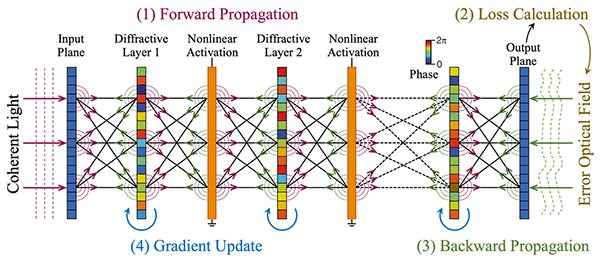The intelligence technology represented by artificial neural networks has brought tremendous changes in various fields. However, the design and training of different artificial neural networks for different target tasks usually involve complex parameter optimization processes. With the continuous growth of the current network scale as well as the confronted bottleneck of Moore's Law, the time cost and energy consumption required for training and implementing artificial neural networks with the electronic computing are dramatically increasing that cannot support the continuous development of artificial intelligence. Optoelectronic computing possesses the advantages of high speed, high parallelism, and low power consumption. Therefore, developing the optical neural networks and its in situ optical training methods based on optoelectronic computing platforms are expected to achieve disruptive improvement in training time, computation speed, and energy efficiency of artificial intelligence systems.
The optoelectronic computing research group led by Prof. Qionghai Dai and Dr. Xing Lin from Tsinghua University in China proposes a universal theory and method for in situ optical backpropagation training, and has successfully verified its operating principles and demonstrated its applications on the diffractive deep neural networks. This work has been published in Photonics Research 2020, Vol. 8, Issue 6 (Tiankuang Zhou, Lu Fang, Tao Yan, et al. In situ optical backpropagation training of diffractive optical neural networks[J]. Photonics Research, 2020, 8(6): 06000940). The Ph.D. student Tiankuang Zhou and Associate Professor Lu Fang are co-first authors, and Dr. Xing Lin and Professor Qionghai Dai are co-corresponding authors.
The existing in situ training methods for optical neural networks have many drawbacks, such as the strict losslessness assumption of a system, which cannot be applied to general types of optical neural networks, including the diffractive neural networks. This study is based on the Huygens-Fresnel principle and optical reciprocity. With the use of optical phase conjugation and optical field sensing techniques, the gradient descent optimization algorithm for in situ optical backpropagation training of diffractive deep neural networks is derived. The proposed method eliminates the assumption that the system is lossless and can be universally applied to optical neural networks. This research laid a theoretical foundation for the construction of high-performance experimental optoelectronic intelligent computing systems in the future.

Figure 1. Schematic of in situ optical backpropagation training of diffractive deep neural networks
The proposed in situ optical training method comprises four steps: the forward propagation, error calculation, backward propagation, and gradient update, as shown in Figure 1. The researchers verified that the theoretical model could achieve accurate gradient calculation by simulating the diffraction neural network to perform the object classification, which obtained a similar classification accuracy as electronic training. It also achieved a relative error of less than 1.5% in the application of all-optical matrix computation. In addition, the proposed method can mitigate the influence of the optical system error on the computation accuracy; and the researchers also applied the in situ training method of the diffractive neural networks to instantaneously correct the imaging distortion caused by the scattering medium, exploring the possibility of integrating optoelectronic computing in terminal intelligent imaging equipment. Compared with the existing electronic training methods, this study proves that the theoretical prototype optical training system can already increase the training speed by 1.65 times and reduce the training power consumption by 2 to 3 orders of magnitude.
The group leader Professor Dai Qionghai pointed out that today's artificial intelligence training requires the massive of time and energy, and the optoelectronic implementation of artificial intelligence training is of great significance for improving the training efficiency. Just as the backpropagation algorithm has stimulated the leap-forward development of artificial neural networks, this work is expected to contribute to the design and implementation of the large-scale integrated optical neural networks.


